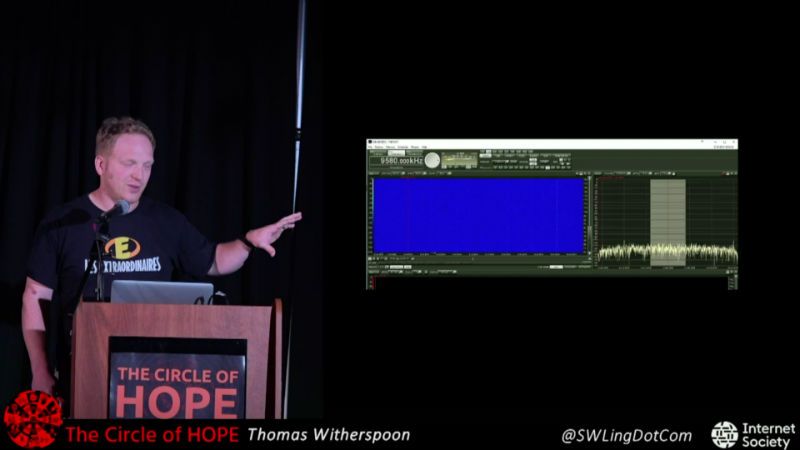Wow! Thank you, Hackaday:
HOPE XII: TIME TRAVEL WITH SOFTWARE DEFINED RADIO
by: Tom Nardi
It’s easy to dismiss radio as little more than background noise while we drive. At worst you might even think it’s just another method for advertisers to peddle their wares. But in reality it’s a snapshot of the culture of a particular time and place; a record of what was in the news, what music was popular, what the weather was like, basically what life was like. If it was important enough to be worth the expense and complexity of broadcasting it on the radio, it’s probably worth keeping for future reference.
But radio is fleeting, a 24/7 stream of content that’s never exactly the same twice. Yet while we obsessively document music and video, nobody’s bothering to record radio. You can easily hop online and watch a TV show that originally aired 50 years ago, but good luck finding a recording of what your local radio station was broadcasting last week. All that information, that rich tapestry of life, is gone and there’s nothing we can do about it.
Or can we? At HOPE XII, Thomas Witherspoon gave a talk called “Creating a Radio Time Machine: Software-Defined Radios and Time-Shifted Recordings”, an overview of the work he’s been doing recording and cataloging the broadcast radio spectrum. He demonstrated how anyone can use low cost SDR hardware to record, and later play back, whole chunks of the AM and shortwave bands. Rather than an audio file containing a single radio station, the method he describes allows you to interactively tune in to different stations and explore the airwaves as if it were live.[…]


Nice article on your presentation Thomas. I would also like to see a recording of it when the whole presentation gets posted.
Radio is becoming more inconvenient for most people. For instance, if I wanted to hear something that I cannot pick up at home during the workday (because of the Noise or limitations on antennas), then I would have to try to remember to record it from my car. But the building management frowns on large antennas attached to a car on a parking deck! So, I am forced to listen as a live stream over the internet anyway (or use the internet to find a KiwiSDR that can pick up the program on radio later that evening at home). If it were not for the internet’s more cumbersome (and expensive) ad revenue model where one is forced to pay subscription fees for every discrete program content one wants to listen/watch, radio would have died a long time ago. Because of this money issue, radio may be with us for longer than the new techies imagine.
The resurgence of Talk radio is especially surprising but understandable since some surmise we have entered a new Cultural Civil War. Hopefully, radio can also help maintain civil dialog and balance the tendency for internet venues to become one-sided echo chambers. There is something more “available” in something that is being broadcast over the air vs. something that one has to type in and hunt for over the internet. Eventually, the internet will become more of an appliance and make it easier to “tune” into various programs without so much subscription fees and walls.
Until then, I think radio still has some sort of important niche to play. Recording some of this history will still be important for future Historians. Not everything is on cable TV. In fact, some more in-depth discussions can still be found on radio and no where else.
Thomas,
I look forward to hearing/viewing your presentation once the good folks at 2600 and Hope put it up online. I’d love to hear about your adventures and experiences of the conference.
The comments on the Hackaday site where the article is posted are interesting. Some don’t see any particular unique cultural value in radio broadcasting and hence why preserve it as a playable spectrum. Of course, Hackaday readers may not be that representative of the wider community, however, what this project (The Spectrum Archive) is all about, capturing the medium for future review and observation.
We are most likely in the last 50 years or so of serial delivery of information by radio. I think radio is fundamentally being disrupted now just as television was/is. In the case of “television”, broadcast RF for quite a while is not the most popular delivery method (ie long replaced by cable and now a strong building trend of cord-cutting IP starting to impact cable itself). Massive amounts of television are now consumed “on demand” rather than in the originally broadcasted timeslot. A growing amount of radio programming is now being consumed as podcasts. Radio wallpaper (ie often what is listened to in cars) is being replaced by Spotify etc. for the under 30’s. IP (4G etc) car radios are now becoming common in many parts of the world.
One of the really fascinating aspects of preserving “radio” this way (in the spectrum format) is that the actual delivery modality that required the tuning to a signal on a particular frequency is also being preserved. The static between stations will be a curiosity for future generations as well, as they will not be consuming media by “tuning a dial” or thinking about a particular frequency or channel.
It’s all good stuff! A great presentation Thomas – keep filling up those hard disks, because in decades to come (50 years away?) the idea that there even was an AM broadcast band will likely be a strange curiosity to the general public.
Well done! Congrats on getting much deserved recognition! Cheers!